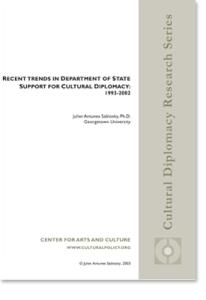
Author: Juliet Antunes Sablosky, Ph.D.
Publication Year: 2003
Media Type: Periodical (article)
Summary:
Cultural diplomacy is back. In the aftermath of the attacks of September 11, 2001 a plethora of articles, reports, and op-ed pieces has appeared, urging greater attention to how the United States, its values, culture, and policies are perceived abroad and to how we can improve those perceptions. Among the recommendations are calls for increased efforts in the area of cultural diplomacy. Ironically, the renewed interest in cultural diplomacy comes at a time when the country’s resources and infrastructure for it are at their lowest levels in recent years. Since 1993, budgets have fallen by nearly 30%, staff has been cut by about 30% overseas and 20% in the U.S., and dozens of cultural centers, libraries and branch posts have been closed.
Abstract:
Cultural diplomacy is back. In the aftermath of the attacks of September 11, 2001 a plethora of articles, reports, and op-ed pieces has appeared, urging greater attention to how the United States, its values, culture, and policies are perceived abroad and to how we can improve those perceptions. Among the recommendations are calls for increased efforts in the area of cultural diplomacy. Ironically, the renewed interest in cultural diplomacy comes at a time when the country’s resources and infrastructure for it are at their lowest levels in recent years. Since 1993, budgets have fallen by nearly 30%, staff has been cut by about 30% overseas and 20% in the U.S., and dozens of cultural centers, libraries and branch posts have been closed.
Before looking at the current situation in detail, some definitions may be in order. One of the early practitioners of cultural diplomacy defined it this way: “A nation’s culture is the sum total of its achievement, its own expression of its own personality; its way of thinking and acting. Its program of cultural relations abroad is its method of making these things known to foreigners.”2 Cultural diplomacy is related to public diplomacy, but whereas the latter addresses both short-term policy needs and long-term interests, cultural diplomacy’s emphasis is on long-term interchange among nations.3 In promoting mutual understanding, it seeks to provide a context within which our national interests and policies can be understood. By their nature cultural diplomacy activities involve long-term investments in our relations with people in other countries. The teenager living in a family abroad for a year may someday become a leading journalist, academic, government official, or businessman. The young parliamentarian who visits with counterparts and tours the United States may one day be prime minister. The artist who works in residency abroad may return to the United States with a new view of her own her country because of her contact with another culture. There is no way to know; a certain degree of faith is involved in cultural diplomacy. Former Secretary of State George Schultz has compared diplomacy to gardening, and his comments seem particularly applicable to cultural diplomacy. “You get the weeds out when they are small. You also build confidence and understanding. Then, when a crisis arises, you have a solid base from which to work.”
How has the United States been “making itself known”? Is the early definition still accurate, or does true cultural diplomacy involve two-way communication of culture and values? If it does, what are the implications for our program of cultural relations? Any discussion of the future will need to address some of the perennial questions, especially those dealing with the goals of cultural diplomacy. In the past there has been little consensus. Is the main objective to support our foreign policy goals? To improve our image? To promote mutual understanding? To improve the international competence of Americans? To balance the image presented abroad by the commercial culture? All of these have been invoked as goals at one time or another, with priorities shifting from administration to administration. What can cultural diplomacy reasonably hope to accomplish in this age of “interconnectedness” - in a world increasingly pervaded by American popular culture, a culture which is simultaneously embraced and excoriated abroad? A look at both past and present day cultural diplomacy may help provide some basis for discussion of the future.
What trends are discernible in the American approach to cultural diplomacy over the years? Is our present investment in cultural relations sufficient? This paper reviews some of the basic elements in the Department of State’s cultural diplomacy program, particularly those related to the arts, looks at budget and staffing trends, and notes some new directions and opportunities, in an effort to provide a framework for further discussion and recommendations. [Introduction]
Arts & Intersections:
Categories: Cultural Diplomacy and Exchange
ADDITIONAL BIBLIOGRAPHICAL INFORMATION
Series Title: Cultural Diplomacy Research Series
Edition:
URL:
SBN/ISSN:
Pages: 20
Resources: Document
PUBLISHER INFORMATION
Name: Center for Arts and Culture
Website URL: http://www.AmericansForTheArts.org